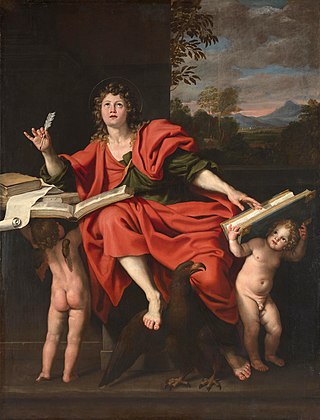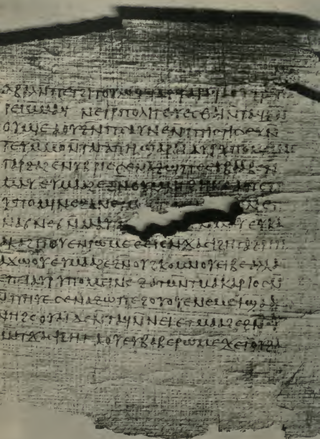In the Platonic, Neopythagorean, Middle Platonic, and Neoplatonic schools of philosophy, the demiurge is an artisan-like figure responsible for fashioning and maintaining the physical universe. The Gnostics adopted the term demiurge. Although a fashioner, the demiurge is not necessarily the same as the creator figure in the monotheistic sense, because the demiurge itself and the material from which the demiurge fashions the universe are both considered consequences of something else. Depending on the system, they may be considered either uncreated and eternal or the product of some other entity.

Gnosticism is a collection of religious ideas and systems that coalesced in the late 1st century AD among Jewish and early Christian sects. These various groups emphasized personal spiritual knowledge (gnosis) above the proto-orthodox teachings, traditions, and authority of religious institutions. Gnostic cosmogony generally presents a distinction between a supreme, hidden God and a malevolent lesser divinity who is responsible for creating the material universe. Consequently, Gnostics considered material existence flawed or evil, and held the principal element of salvation to be direct knowledge of the hidden divinity, attained via mystical or esoteric insight. Many Gnostic texts deal not in concepts of sin and repentance, but with illusion and enlightenment.

The Gospel of John is the fourth of the four canonical gospels in the New Testament. It contains a highly schematic account of the ministry of Jesus, with seven "signs" culminating in the raising of Lazarus and seven "I am" discourses culminating in Thomas' proclamation of the risen Jesus as "my Lord and my God". The gospel's concluding verses set out its purpose, "that you may believe that Jesus is the Christ, the Son of God, and that believing you may have life in his name."

Irenaeus was a Greek bishop noted for his role in guiding and expanding Christian communities in the southern regions of present-day France and, more widely, for the development of Christian theology by combating heterodox or Gnostic interpretations of Scripture as heresy and defining proto-orthodoxy. Originating from Smyrna, he had seen and heard the preaching of Polycarp, who in turn was said to have heard John the Evangelist, and thus was the last-known living connection with the Apostles.

The Gospel of Thomas is an extra-canonical sayings gospel. It was discovered near Nag Hammadi, Egypt, in December 1945 among a group of books known as the Nag Hammadi library. Scholars speculate that the works were buried in response to a letter from Bishop Athanasius declaring a strict canon of Christian scripture. Scholars have proposed dates of composition as early as 60 AD and as late as 250 AD. Since its discovery, many scholars have seen it as evidence in support of the existence of a "Q source" which might have been very similar in its form as a collection of sayings of Jesus without any accounts of his deeds or his life and death, referred to as a sayings gospel.

The Nag Hammadi library is a collection of early Christian and Gnostic texts discovered near the Upper Egyptian town of Nag Hammadi in 1945.
Cerinthus was an early Gnostic, who was prominent as a heresiarch in the view of the early Church Fathers. Contrary to the Church Fathers, he used the Gospel of Cerinthus, and denied that the Supreme God made the physical world. In Cerinthus' interpretation, the Christ descended upon Jesus at baptism and guided him in ministry and the performing of miracles, but left him at the crucifixion. Similarly to the Ebionites, he maintained that Jesus was not born of a virgin, but was a mere man, the biological son of Mary and Joseph.

Elaine Pagels, née Hiesey, is an American historian of religion. She is the Harrington Spear Paine Professor of Religion at Princeton University. Pagels has conducted extensive research into early Christianity and Gnosticism.

The Gospel of Philip is a non-canonical Gnostic Gospel dated to around the 3rd century but lost in medieval times until rediscovered by accident, buried with other texts near Nag Hammadi in Egypt, in 1945.

The Alogi (ἄλογοι), also called Alogoi or Alogians, were a group of heterodox Christians in Asia Minor that flourished c. 200 CE, and taught that the Gospel of John and the Apocalypse of John were not the work of the Apostle, but his adversary Cerinthus. What we know of them is derived from their doctrinal opponents, whose literature is extant, particularly Epiphanius of Salamis. It was Epiphanius who coined the name "Alogi" as a word play suggesting that they were both illogical and they were against the Christian doctrine of the Logos. While Epiphanius does not specifically indicate the name of its founder, Dionysius Bar-Salibi, citing a lost work of Hippolytus, writes in his commentary on the Apocalypse,
Hippolytus of Rome says: A man appeared, named Caius, saying that the Gospel is not by John, nor the Apocalypse but that it is by Cerinthus the heretic.

The New Testament apocrypha are a number of writings by early Christians that give accounts of Jesus and his teachings, the nature of God, or the teachings of his apostles and of their lives. Some of these writings were cited as scripture by early Christians, but since the fifth century a widespread consensus has emerged limiting the New Testament to the 27 books of the modern canon. Roman Catholic, Eastern Orthodox, and Protestant churches generally do not view the New Testament apocrypha as part of the Bible.

The authorship of the Johannine works has been debated by biblical scholars since at least the 2nd century AD. The debate focuses mainly on the identity of the author(s), as well as the date and location of authorship of these writings.

The Gospel of Mary is a non-canonical text discovered in 1896 in a fifth-century papyrus codex written in Sahidic Coptic. This Berlin Codex was purchased in Cairo by German diplomat Carl Reinhardt.

The Gospel of the Truth is one of the Gnostic texts from the New Testament apocrypha found in the Nag Hammadi codices ("NHC"). It exists in two Coptic translations, a Subakhmimic rendition surviving almost in full in the first Nag Hammadi codex and a Sahidic in fragments in the twelfth codex.

The Epistle of the Apostles is a work of New Testament apocrypha. Despite its name, it is more a gospel or an apocalypse than an epistle. The work takes the form of an open letter purportedly from the remaining eleven apostles describing key events of the life of Jesus, followed by a dialogue between the resurrected Jesus and the apostles where Jesus reveals apocalyptic secrets of reality and the future. It is 51 chapters long. The epistle was likely written in the 2nd century CE in Koine Greek, but was lost for many centuries. A partial Coptic language manuscript was discovered in 1895, a more complete Ethiopic language manuscript was published in 1913, and a full Coptic-Ethiopic-German edition was published in 1919.

Marvin W. Meyer was a scholar of religion and a tenured professor at Chapman University, in Orange, California.

Traditionally in Christianity, orthodoxy and heresy have been viewed in relation to the "orthodoxy" as an authentic lineage of tradition. Other forms of Christianity were viewed as deviant streams of thought and therefore "heterodox", or heretical. This view was challenged by the publication of Walter Bauer's Rechtgläubigkeit und Ketzerei im ältesten Christentum in 1934. Bauer endeavored to rethink Early Christianity historically, independent from the views of the current church. He stated that the 2nd-century church was very diverse and included many "heretical" groups that had an equal claim to apostolic tradition. Bauer interpreted the struggle between the orthodox and heterodox to be the "mainstream" Church of Rome struggling to attain dominance. He presented Edessa and Egypt as places where the "orthodoxy" of Rome had little influence during the 2nd century. As he saw it, the theological thought of the "Orient" at the time would later be labeled "heresy". The response by modern scholars has been mixed. Some scholars clearly support Bauer's conclusions and others express concerns about his "attacking [of] orthodox sources with inquisitional zeal and exploiting to a nearly absurd extent the argument from silence." However, modern scholars have critiqued and updated Bauer's model.

Thomasine is a name given to a Syrian Christian group that originated in the first or the second century, who especially revered the apostle Thomas and some scholars speculate to have written the gospel of Thomas. The group was said to have held esoteric, mystical, and ascetic ideas. Some have associated them with the proto-Gnostics. However modern critics have disputed their affiliation with Gnosticism, especially because they lack many uniquely Gnostic beliefs.
In Sethian Gnosticism, a luminary is an angel-like being. Four luminaries are typically listed in Sethian Gnostic texts, such as the Secret Book of John, the Holy Book of the Great Invisible Spirit, and Zostrianos. The luminaries are considered to be emanations of the supreme divine triad consisting of the Father, the Mother (Barbelo), and the Child (Autogenes). Listed from highest to lowest hierarchical order, they are:
- Harmozel
- Oroiael
- Daveithe
- Eleleth











